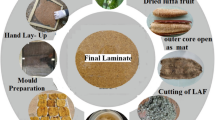Summary
The springback of compressed wood caused by built-up internal stresses results in excessive thickness swelling of wood-based composites when exposed to moisture. Steam pretreatment can cause partial hydrolysis of hemicellulose for both hardwoods and softwoods which markedly increases the compressibility of wood and in turn significantly reduces the build-up of internal stresses in composites during hot pressing. This steam pretreatment process is a very effective method for producing dimensionally stable wood-based composites. Mild steam pretreatments (e.g. 3 to 4 min at 1.55 MPa) cause a significant reduction of the water insoluble xylan content in hardwoods and the amount of xylan, mannan and galactan in softwoods without any apparent changes in the cellulose or lignin content.
Similar content being viewed by others
References
ASTM D1037.72A. 1986: Standard methods of evaluating the properties of wood-based fiber and particle panel materials. 1986 Annual book of ASTM Standards, Part 22. Wood; Adhesives. American Society for Testing and Materials. Philadelphia, Pa. U.S.A.
Brownell, H. H.; Saddler, J. N. 1987: Steam pretreatment of lignocellulosic material for enhanced enzymatic hydrolysis. Biotechnol. Bioeng. 29:228–235
BS 5669. 1979: Specification for wood chipboard and methods of test for particleboard. British Standards Institution
Chua, M. G. S.; Wayman, M. 1979: Characterization of autohydrolysis aspen (P. tremuloides) lignins. Part I: Composition and molecular weight distribution of extracted autohydrolysis lignin. Can. J. Chem. 57:1141–1149
Hillis, W. E. 1984: High temperature and chemical effects on wood stability. Wood Sci. Technol. 18:281–293
Horn, R. A. 1979: Bonding in press-dried sheets from high-yield pulps. The role of lignin and hemicelluloses. Tappi 62:77–80
Hsu, W. E. 1986: Canadian Patent 1215510. Method of making dimensionally stable composite board and composite board produced by such method
Irick, T. J.; West, K.; Brownell, H. H.; Schwald, W.; Saddler, J. N. 1987: Comparison of colorimetric and HPLC techniques for quantitating the carbohydrate components of steam-treated wood. 9th Symposium on Biotechnology for Fuels and Chemicals. May 5–8 Boulder, Colorado
Pettersen, R. C.; Schwandt, V. H.; Effland, M. J. 1984: An analysis of the wood sugar assay using HPLC: a comparison with paper chromatography. J. Chromatogr. Sci 22:478–484
TAPPI T222 OS74. 1974: Acid-insoluble lignin in wood and pulp. Technical Association of the Pulp and Paper Industry. Atlanta, G.A., U.S.A.
TAPPI Useful method 250. 1976: Acid-soluble lignin in wood and pulp. Technical Association of the Pulp and Paper Industry. G.A., U.S.A.
Author information
Authors and Affiliations
Additional information
The authors wish to thank G. Bastien and B. S. Lethbridge for technical assistance. W. Schwald is grateful to the ‘Fonds zur Förderung der wissenschaftlichen Forschung’, Vienna, Austria for granting an ‘Erwin-Schrödinger scholarship’ (Proj. No. J0128C)
Rights and permissions
About this article
Cite this article
Hsu, W.E., Schwald, W., Schwald, J. et al. Chemical and physical changes required for producing dimensionally stable wood-based composites. Wood Sci.Technol. 22, 281–289 (1988). https://doi.org/10.1007/BF00386023
Received:
Issue Date:
DOI: https://doi.org/10.1007/BF00386023




